Hana Financial Group Bundle
Who Really Controls Hana Financial Group?
Understanding the ownership of a financial powerhouse like Hana Financial Group is crucial for anyone seeking to navigate the complexities of the global market. Knowing Hana Financial Group SWOT Analysis can also provide a deeper understanding of its position. This exploration will peel back the layers of Hana Group ownership, revealing the key players and their influence on this major South Korean financial institution. From its beginnings to its current status, the ownership structure tells a compelling story.
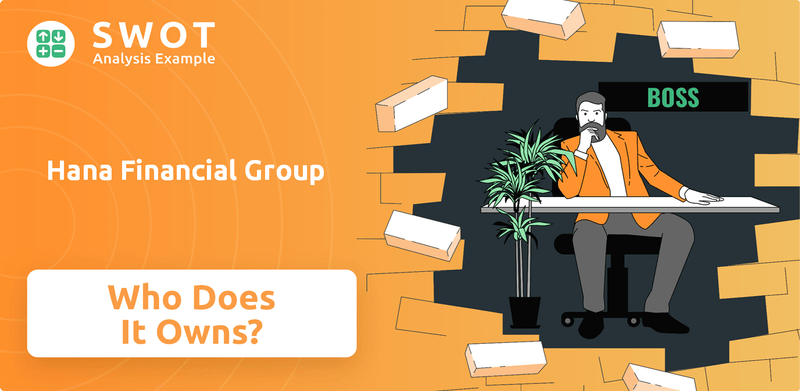
Delving into the Hana Financial Group shareholders and the Hana Financial Group structure is vital for grasping its strategic direction. Examining who owns Hana, including the major investors and the board of directors, offers critical insights into the company's future. This analysis will uncover the dynamics of Hana Bank ownership structure and the broader implications for its financial performance and leadership.
Who Founded Hana Financial Group?
The story of Hana Financial Group begins with the Korea Investment Finance Corporation, established in 1971. This entity later evolved into Hana Bank in 1991. The transformation into the financial holding company, Hana Financial Group Inc., occurred in December 2005, marking a significant shift in its ownership structure.
While specific details about the founders' names, their initial equity split, or shareholding percentages from 1971 are not readily available, the move to a holding company in 2005 reshaped the ownership framework. This transition reflected a consolidation of ownership under the new holding company structure.
During its early years as Hana Bank, the institution expanded through acquisitions. These included Chungcheong Bank in 1998, Boram Bank in 1999, and Seoul Bank in 2002. These mergers inherently changed the ownership landscape, introducing new shareholders from the acquired entities.
The foundation of Hana Financial Group can be traced back to the Korea Investment Finance Corporation, established in 1971.
In 1991, Korea Investment Finance Corporation transitioned into Hana Bank, marking a significant milestone in its development.
The financial holding company, Hana Financial Group Inc., was established in December 2005, reshaping its ownership framework.
Early expansion included acquiring Chungcheong Bank in 1998, Boram Bank in 1999, and Seoul Bank in 2002.
The mergers and the eventual formation of the holding company suggest a dynamic evolution of Hana Group ownership from its earliest days.
In 2005, Hana Bank was delisted and incorporated as a subsidiary, indicating a consolidation of ownership under the new holding company.
The Hana Financial Group shareholders structure has evolved significantly since its inception. The formation of the holding company in 2005 consolidated ownership, with Hana Bank becoming a subsidiary. The Hana Financial Group structure includes various subsidiaries, reflecting its growth through mergers and acquisitions. For a deeper understanding of the target market, consider reading about the Target Market of Hana Financial Group. The company's history shows a continuous adaptation of its ownership model to support its expansion and strategic goals. As of the latest reports, the company continues to adapt to the changing financial landscape.
Hana Financial Group SWOT Analysis
- Complete SWOT Breakdown
- Fully Customizable
- Editable in Excel & Word
- Professional Formatting
- Investor-Ready Format
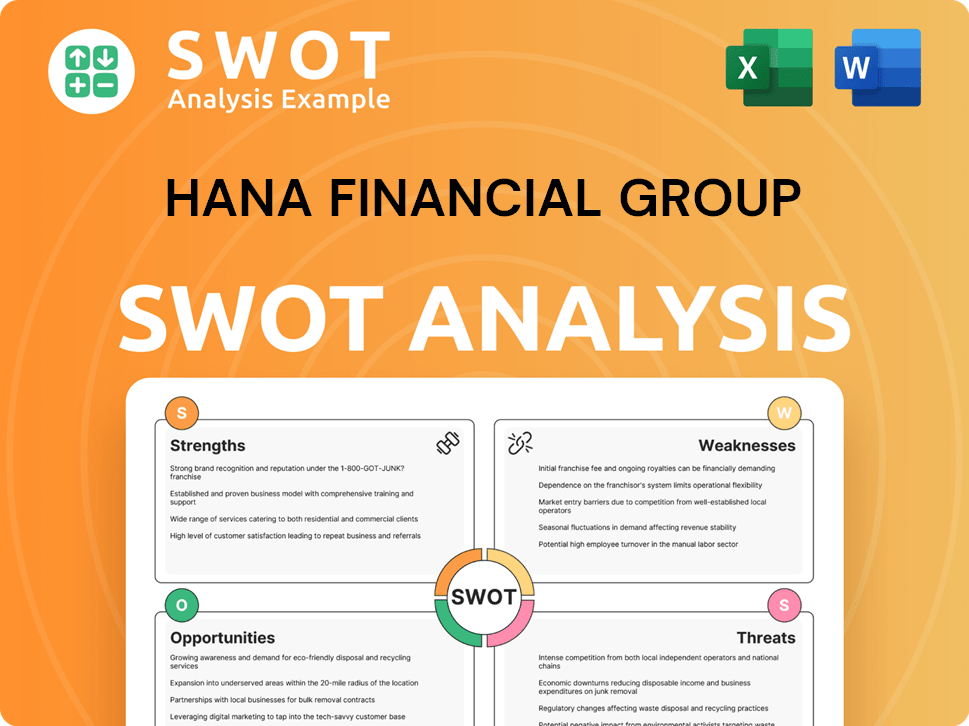
How Has Hana Financial Group’s Ownership Changed Over Time?
The ownership structure of Hana Financial Group has seen significant changes since its establishment in 2005. The company's journey began with the acquisition of Daehan Investment and Securities, then Korea's second-largest asset management company. A pivotal moment arrived in 2012 when the group acquired a 51.02% stake in Korea Exchange Bank (KEB) from Lone Star Funds for KRW 2.02 trillion. This led to the merger of KEB and Hana Bank in 2015, forming KEB Hana Bank, which substantially reshaped the group's market position. Further expansion included acquiring an 18.44% stake in the Bank of Jilin Co. Ltd. and forming a strategic alliance with China Merchants Bank in 2011.
These strategic moves highlight Hana Financial Group's proactive approach to growth and market consolidation. The acquisitions and alliances have not only diversified its portfolio but also strengthened its presence in both domestic and international markets. These changes have been instrumental in shaping the current ownership landscape, which is largely influenced by institutional investors.
| Shareholder | Stake (as of March 31, 2025) | Notes |
|---|---|---|
| National Pension Service of Korea | 9.23% | Largest shareholder |
| Capital Group | 6.95% (as of December 27, 2024) | Second-largest shareholder |
| BlackRock Fund Advisors | 6.38% (as of March 18, 2022) | Significant institutional investor |
| SK Telecom Co., Ltd. | 3.00% | Strategic investor |
| The Government of Singapore | 2.43% | Sovereign wealth fund |
Institutional investors currently hold approximately 53.7% of Hana Financial Group's shares as of February 1, 2025, with the top 25 shareholders controlling 44% of the business. The National Pension Service of Korea is the largest shareholder with 9.23% of common shares as of March 31, 2025. Capital Group has become the second-largest shareholder, holding 6.95% as of December 27, 2024. Other major stakeholders include BlackRock Fund Advisors, SK Telecom Co., Ltd., and The Government of Singapore. The substantial institutional holdings indicate strong confidence in the company's future, reflecting the company's robust financial health and strategic positioning, as discussed in the Growth Strategy of Hana Financial Group.
Understanding the ownership structure of Hana Financial Group is crucial for investors and stakeholders. The group's evolution through strategic acquisitions has shaped its current landscape.
- Institutional investors play a significant role, holding a majority of the shares.
- The National Pension Service of Korea and Capital Group are major shareholders.
- The ownership structure reflects confidence in the company's long-term prospects.
- Hana Bank ownership structure is a key factor.
Hana Financial Group PESTLE Analysis
- Covers All 6 PESTLE Categories
- No Research Needed – Save Hours of Work
- Built by Experts, Trusted by Consultants
- Instant Download, Ready to Use
- 100% Editable, Fully Customizable
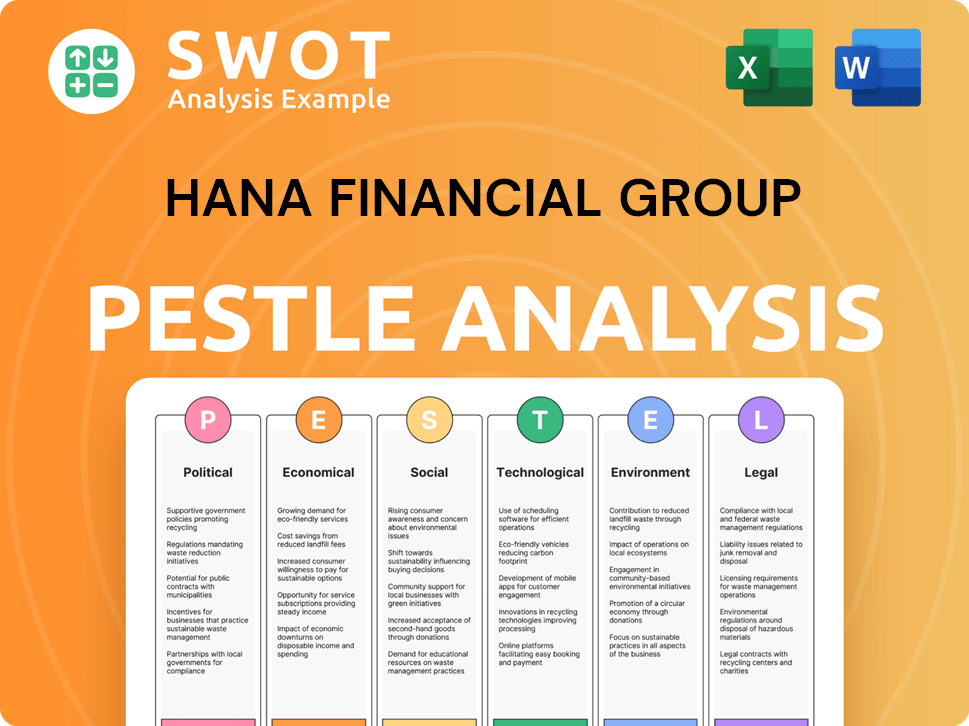
Who Sits on Hana Financial Group’s Board?
The Board of Directors of Hana Financial Group is key to its governance, supervising strategic decisions and management. The board includes both executive and independent directors. At the 20th Ordinary General Shareholder's Meeting on March 25, 2025, the agenda included the election of independent directors such as Park Dong-moon, Lee Kang-won, Yi June-suh, and Suh Young-sook, along with executive directors Lee Seung-lyul and Kang Seong-muk. Ham Young-joo, the Chairman and CEO, was also re-elected as an independent director. The board also includes independent directors serving on the Audit Committee, such as Won Sook-yeon, Park Dong-moon, and Lee Jae-min.
The composition of the board reflects a commitment to professional and independent operation, ensuring that the interests of all stakeholders are considered in decision-making. This structure supports the company's commitment to transparent corporate governance. For more details, explore the Brief History of Hana Financial Group.
| Director | Role | Meeting Date |
|---|---|---|
| Ham Young-joo | Chairman and CEO, Independent Director | March 25, 2025 |
| Park Dong-moon | Independent Director, Audit Committee Member | March 25, 2025 |
| Lee Kang-won | Independent Director | March 25, 2025 |
| Yi June-suh | Independent Director | March 25, 2025 |
| Suh Young-sook | Independent Director | March 25, 2025 |
| Lee Seung-lyul | Executive Director | March 25, 2025 |
| Kang Seong-muk | Executive Director | March 25, 2025 |
| Won Sook-yeon | Independent Director, Audit Committee Member | March 25, 2025 |
| Lee Jae-min | Independent Director, Audit Committee Member | March 25, 2025 |
Regarding voting power, Hana Financial Group operates under a one-share-one-vote system. In March 2025, Chairman and CEO Ham Young-joo was reappointed for another three-year term with 81.2% shareholder support, indicating strong confidence in his leadership. This appointment followed recommendations from a board committee after interviews with shortlisted candidates. The company's governance emphasizes transparent corporate governance to protect shareholder and financial consumer interests.
The Board of Directors at Hana Financial Group includes both executive and independent members, ensuring diverse perspectives and oversight.
- The company uses a one-share-one-vote structure, maintaining equitable voting rights for shareholders.
- Chairman and CEO Ham Young-joo's reappointment in March 2025 reflects strong shareholder confidence.
- The governance structure focuses on transparency to protect shareholder and consumer interests.
Hana Financial Group Business Model Canvas
- Complete 9-Block Business Model Canvas
- Effortlessly Communicate Your Business Strategy
- Investor-Ready BMC Format
- 100% Editable and Customizable
- Clear and Structured Layout
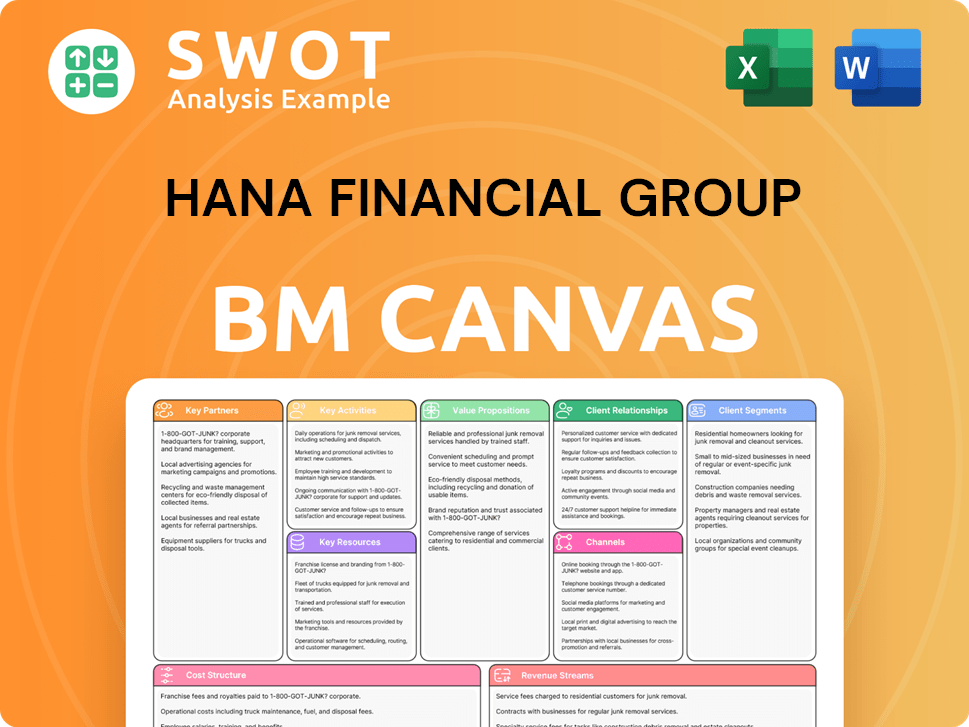
What Recent Changes Have Shaped Hana Financial Group’s Ownership Landscape?
Recent developments at Hana Financial Group highlight a strong emphasis on shareholder value and strategic expansion. In February 2025, the group initiated a significant share buyback plan, allocating 400 billion won (approximately $280 million) to retire shares. This move is part of a broader 'value-up' strategy, targeting a total shareholder return (TSR) of 50% by 2027, a substantial increase from the 38% reported in 2024. Furthermore, the company is implementing consistent cash dividends, including both fixed annual and evenly distributed quarterly payments, to enhance shareholder predictability. These actions underscore Hana Financial Group's commitment to rewarding its investors and improving its financial standing.
A key aspect of Hana Financial Group's ownership structure is the significant presence of institutional investors. As of February 1, 2025, institutional ownership stood at around 51%. Major investors include the National Pension Service of Korea, holding 9.23% as of March 31, 2025, and Capital Group, with 6.95% as of December 27, 2024. BlackRock Fund Advisors also maintains a notable stake of 6.38% as of March 18, 2022. The support from proxy advisors like Glass, Lewis & Co. for the reappointment of Chairman and CEO Ham Young-joo in March 2025, especially given that foreign investors own about 67% of the company, demonstrates the influence of both institutional and foreign ownership on the company's governance and strategic decisions. For a deeper dive into the competitive environment, consider reading about the Competitors Landscape of Hana Financial Group.
Ham Young-joo's re-election through March 2028 signals a continued strategic focus on growing the non-banking sector. The goal is to increase its contribution to the group's net profit from 16% at the end of 2024 to 30% by 2027. This strategic direction involves strengthening subsidiaries such as Hana Securities, Hana Card, and Hana Insurance. A notable move includes the planned merger of Hana Asset Management and Hana Alternative Asset Management, expected as early as later in 2025, to enhance non-banking services. Hana Asset Management became a wholly owned subsidiary in 2023 after acquiring the remaining 51% stake from UBS. These initiatives reflect a concerted effort to diversify revenue streams and boost overall corporate value for shareholders, making Hana Financial Group a dynamic player in the financial market.
Hana Financial Group's ownership structure includes substantial institutional ownership, approximately 51% as of February 1, 2025. Key institutional investors like the National Pension Service and Capital Group hold significant stakes.
The company is focused on enhancing shareholder returns through a share buyback program and a 'value-up' strategy. The aim is to increase the total shareholder return (TSR) to 50% by 2027, up from 38% in 2024.
The re-election of Ham Young-joo as CEO emphasizes the expansion of the non-banking business. The goal is to increase its contribution to net profit to 30% by 2027, up from 16% at the end of 2024.
Major institutional investors include the National Pension Service of Korea, holding 9.23% as of March 31, 2025, and Capital Group, with 6.95% as of December 27, 2024.
Hana Financial Group Porter's Five Forces Analysis
- Covers All 5 Competitive Forces in Detail
- Structured for Consultants, Students, and Founders
- 100% Editable in Microsoft Word & Excel
- Instant Digital Download – Use Immediately
- Compatible with Mac & PC – Fully Unlocked
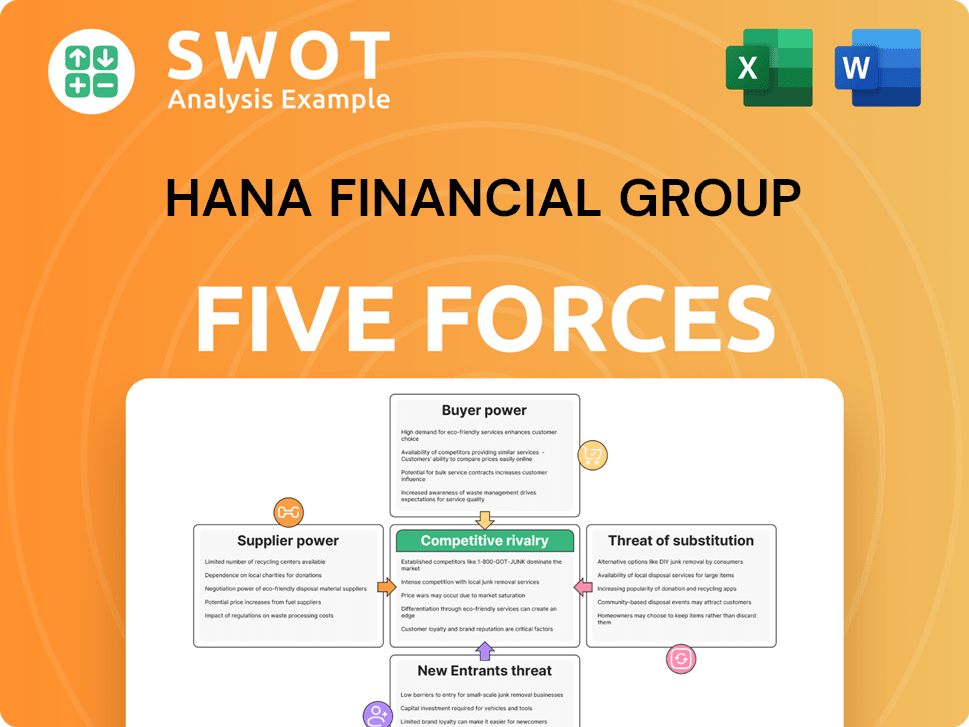
Related Blogs
- What are Mission Vision & Core Values of Hana Financial Group Company?
- What is Competitive Landscape of Hana Financial Group Company?
- What is Growth Strategy and Future Prospects of Hana Financial Group Company?
- How Does Hana Financial Group Company Work?
- What is Sales and Marketing Strategy of Hana Financial Group Company?
- What is Brief History of Hana Financial Group Company?
- What is Customer Demographics and Target Market of Hana Financial Group Company?
Disclaimer
All information, articles, and product details provided on this website are for general informational and educational purposes only. We do not claim any ownership over, nor do we intend to infringe upon, any trademarks, copyrights, logos, brand names, or other intellectual property mentioned or depicted on this site. Such intellectual property remains the property of its respective owners, and any references here are made solely for identification or informational purposes, without implying any affiliation, endorsement, or partnership.
We make no representations or warranties, express or implied, regarding the accuracy, completeness, or suitability of any content or products presented. Nothing on this website should be construed as legal, tax, investment, financial, medical, or other professional advice. In addition, no part of this site—including articles or product references—constitutes a solicitation, recommendation, endorsement, advertisement, or offer to buy or sell any securities, franchises, or other financial instruments, particularly in jurisdictions where such activity would be unlawful.
All content is of a general nature and may not address the specific circumstances of any individual or entity. It is not a substitute for professional advice or services. Any actions you take based on the information provided here are strictly at your own risk. You accept full responsibility for any decisions or outcomes arising from your use of this website and agree to release us from any liability in connection with your use of, or reliance upon, the content or products found herein.